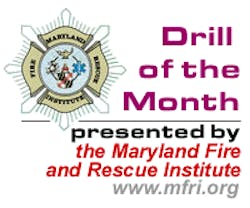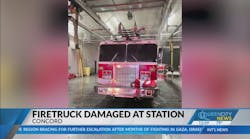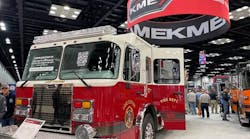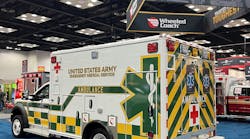Being the driver of an emergency vehicle places greater responsibility on the shoulders of an individual than those of driving a personal vehicle.
Downloadable Instructor's Guides
Session Reference:
Topic: Apparatus Driving And Operations
Teaching and Learning Domain:
Level of Instruction:
Time Required: 2 Hours
Materials:
- Appropriate audio-visual materials
References:
- Fire Department Safety Officer, 1st ed., International Fire Service Training Association
- Pumping Apparatus Driver/Operator Handbook, 1st ed., International Fire Service Training Association
- Emergency Vehicle Driver Training, United States Fire Administration; Maryland Emergency Vehicle Operations Laws
Preparation
Motivation: Being the driver of an emergency vehicle places greater responsibility on the shoulders of an individual than those of driving a personal vehicle. Vehicle size and handling, configuration, and special conditions under which the vehicle is operated must be considered by a driver or potential driver. If the driver does not take all of these items seriously, the apparatus will not arrive at the scene safely.
Objective (SPO): The firefighter will demonstrate a general knowledge of the requirements to drive and operate fire apparatus safely.
Overview: Apparatus Driving And Operations
- Qualifications/Screening
- Program Outline
- Documentation
- Re-evaluation
Instructors Notes: This drill is not intended to replace an emergency vehicle operation training program. It is designed to provide an overview of a program to manage drivers of emergency vehicles in both an emergency and a non-emergency mode.
Apparatus Driving And Operations
SPO 1-1 The firefighter will demonstrate a general knowledge of the requirements to drive and operate fire apparatus safely.EO 1-1
Describe the general requirements and process to become a driver of fire apparatus.
EO 1-2
Identify the elements of a fire apparatus driver program.
EO 1-3
Identify the documentation requirements associated with a fire apparatus driver program.
EO 1-4
Describe the need to re-evaluate fire apparatus drivers
Instructional Guide
I. QUALIFICATIONS/SCREENING (EO 1-1)
- Introduction
- Fire apparatus operators are responsible for safely transporting firefighters, apparatus, and equipment to and from scene of an emergency or other service call
- When the operator is under the direct supervision of an officer, the officer is accountable for actions of operator
- Operator guidelines are found in NFPA 1500, Standard on Fire Department Occupational Safety and Health Program, and NFPA 1002, Standard on Fire Apparatus Driver/Operator Professional Qualifications
- Skills and Physical Abilities Needed
- Reading Skills
- Read maps
- Review manufacturer's operating instructions
- Study prefire plans
- Review printed computer dispatch instructions
- Read and work on a mobile dispatch terminal
- Writing Skills
- Maintenance reports
- Equipment repair requests
- Fire reports
- Accident reports
- Mathematical Skills
- Hydraulic calculations
- Aerial ladder placement and operation
- Physical Fitness
- No impairment of the use of foot, leg, arm, or fingertips, or any other structural defect or limitation likely to interfere with safe driving
- Not have diabetes mellitus to a degree presently requiring the use of insulin for control
- No heart condition likely to cause loss of consciousness or sudden death
- No respiratory ailment likely to interfere with safe driving
- No arthritic, rheumatic, muscular or vascular condition which interferes with the ability to drive safely
- Not have epilepsy or any other condition likely to cause sudden loss of consciousness or loss of ability to control a vehicle
- No mental, nervous, organic, or functional disease, or any psychiatric condition likely to interfere with safe driving
- Meet the following minimum vision requirements: At least 20/40 (Snellen) in each eye and in both together, with or without glasses; at least 70 degrees side vision in each eye; the ability to distinguish red, green, and yellow (or amber)
- Meet hearing requirements by perceiving a forced whisper at five feet with the better ear, or meet specified requirements as measured by a testing device, with or without a hearing aid
- Evaluate medication (if taken) to determine if any chemical impairment would result and interfere with their ability to operate an emergency vehicle
- Not be diagnosed as an alcoholic
- Reading Skills
- Selection
- Required time in service
- Written or performance tests
- Combination of service time and tests
- Based on skill and ability rather than seniority or position
II. PROGRAM OUTLINE (EO 1-2)
- Driver Training Program
- Classroom Orientation
- Collision statistics and causes
- Driving regulations
- Starting the vehicle
- Operating the road transmission
- Cruising with the vehicle
- Stopping the apparatus
- Engine idling
- Engine shutdown
- Driver attitude
- Apparatus rider safety
- Backing the vehicle
- Defensive driving techniques including anticipating other drivers' actions, visual lead time, braking and reaction time, weight transfer, and combating skids
- Auxiliary braking systems
- Warning devices and clearing traffic
- Adverse weather
- Traffic control devices
- Pre-response preventive maintenance inspection
- Driver exercises and evaluation
- Maryland Emergency Vehicle Motor Vehicle Laws Summary
- Park or stand as needed
- Pass a red or stop signal, a stop sign, or a yield sign, but only after slowing down, as necessary for safety
- Exceed any maximum speed limit, but only so long as the driver does not endanger life and property
- Disregard any traffic control device or regulation governing direction of movement or turning in a specific direction
- A vehicle is not considered an emergency vehicle unless it is so licensed or authorized, is responding to an emergency, and is utilizing audible and visual warning devices
- An emergency vehicle may not overtake a school bus that is stopped and operating warning devices
- Drivers of emergency vehicles are expected to operate vehicles in a safe and prudent manner
- Written test
- State and local driving regulations for emergency and non-emergency situations
- Departmental regulations
- Hydraulic calculations
- Specific operational questions regarding fire pump or aerial device
- Department standard operating procedures
- Practical driving range exercises
- Serpentine exercise
- Stall parking (alley dock) exercise
- Lane change (opposite alley) exercise
- Turning around (turnabout) exercise
- Diminishing lane clearance exercise
- Vertical clearance judgment exercise (if prop available)
- Left/right lateral evasive maneuvering exercise
- Controlled braking exercise
- Classroom Orientation
- Licensing
- While these are national guidelines, each state has authority to alter them as it deems necessary for its jurisdiction
- Some states require a fire apparatus operator to obtain a commercial driver's license (CDL) NOTE: Maryland does not require a CDL to drive and operate fire apparatus. They have two different tracks that can be followed. One is based on the CDL program by issuing a specific license based on the weight class of the vehicle but non-commercial. The other is specific licensing authorization that can very from county to county.
- If a member should have his license suspended or revoked or have restrictions placed on it, member must not be allowed to operate fire department apparatus
- Operating Policies and Practices
- Department emergency response SOPs should include following guidelines:
- Knowing maximum apparatus speed during response
- Approaching and entering intersections safely
- Crossing railroad grade crossings safely
- Operating in school zones or passing school buses properly
- Using audible and visual warning devices properly
- Providing right-of-way for other responding apparatus appropriately
- If situation occurs that requires rearward movement of vehicle, then one and preferably two firefighters with portable radios should be assigned to direct driver/operator
- Knowing policies include safe driving practices, adhering to all local and state traffic laws, and defensive driving techniques
- Being familiar with issues such as correct rearward movement of the apparatus, correct parking techniques, and unsafe practices such as standing while the apparatus is in motion
- In event that a department apparatus is involved in a collision, operator must be familiar with protocol for reporting such an event
- Apparatus is under the care and control of operator, who is ultimately responsible for its operation
- Scene Placement Guidelines
- Company officers and apparatus operators must be trained in general guidelines for safe and effective apparatus placement
- Placement guidelines may be in department's standard operating procedures manual or in incident management plan
- Proper positioning of apparatus provides a safety barrier that protects scene, victims, and emergency personnel
- When positioning apparatus, operators must allow for adequate parking of additional fire department apparatus
- Where possible, operators should position apparatus at a 45-degree angle into curb
- At intersections or where incident may be near the middle of street, two or more sides of incident may need to be protected
- During pump operation, pump panel should be positioned at curbside if possible
- When laying hose and positioning at a water source, operator must take necessary steps to warn motorists of these operations
- For safety considerations, operator must not position apparatus under overhead power lines, too close to a potential structural collapse/fire spread, or in access or egress path of other apparatus
- Operator should chock apparatus wheels when vehicle is parked at incident scene
- Operator must ensure that all persons on apparatus are seated and belted
- Visual warning devices must be turned off while returning to quarters
- Department emergency response SOPs should include following guidelines:
- Good driving practices
- Remember that speed is less important than arriving safely at the destination
- Slow down for intersections and stop when faced with a red light or stop sign; anticipate the worst possible situation
- Drive defensively and be aware of everything that is happening or likely to happen 360 degrees around the apparatus
- Expect that some motorists and pedestrians will neither hear nor see the apparatus warning devices
- Be aware of the route's general road and traffic conditions and adjust this expectation with the season, weather, day of the week, and time of day
- Remember that icy, wet, or snow-packed roads increase braking distance
- Do not grind the gears on manual transmission vehicles
- Do not use the clutch pedal as a footrest
- Do not exceed 10 mph when leaving the station
- Do not race the engine when the apparatus is standing still as it is unnecessary and abuses the engine
- Always use low gear when starting from a standstill because using second or third gear and slipping the clutch damages the clutch and causes unnecessary, rapid wear
- Keep the apparatus under control at all times
- Take nothing for granted
III. DOCUMENTATION (EO 1-3) Driving Range Exercise
- Driving Range Exercise
- Do not let candidate go on the road until this portion is successfully completed
- If the candidate does not perform successfully, it should be documented
- Indicate pass date and instructor signature when each items is successfully completed
- A separate evaluation should be conducted for each piece of apparatus that the individual is being trained to drive
- Road Test - Have at least 15 miles of driving experience in traffic to demonstrate the following during the road test segment of the training:
- Road tests
- Four left and four right turns
- Straight section of urban business street or two-lane rural road at least one mile in length
- One through intersection and two intersections where a stop must be made
- Railroad crossing
- One curve, either left or right
- Section of limited access highway that includes a conventional on-ramp, off-ramp, and is long enough to allow for at least two lane changes
- Downgrade that is steep enough and long enough to require gear changing to maintain speed
- Upgrade that is steep enough and long enough to require gear changing to maintain speed
- One underpass, low-clearance bridge
- Items to consider during the road test
- Leaving the curb
- Speed control
- Smoothness of operation
- Shifting gears
- Anticipates traffic problems
- Obeys traffic laws
- Signals properly
- Allows sufficient passing room
- Passes cautiously and smoothly
- Uses mirrors
- Signals well in advance
- Turns from proper lane
- Looks all around before turning
- Turns at proper speed
- Turns into proper lane
- Yields right-of-way
- Document any deficiencies and retraining recommendations
- Indicate pass date and instructor signature when each items is successfully completed
- A separate evaluation should be conducted for each piece of apparatus that the individual is being trained to drive
- Road tests
IV. RE-EVALUATION (EO 1-4)
- Why Re-Evaluate
- Individual may not have driven and/or operated a particular piece of apparatus in a reasonable timeframe
- Replacement apparatus
- Individual may have undergone some medical treatment
- Individual may have been involved in a motor vehicle accident
- Automatic requirement on a periodic basis
- May help to control or reduce vehicle insurance rates
- May be required due to an excessive number of motor vehicle accidents
- Conducted anytime there is concern about the driver's ability to drive and operate the apparatus
- What Is Involved
- As a minimum, the individual should be required to demonstrate proficiency in driving and operating the particular piece of apparatus
- A written test may also be included
- Hydraulic calculations may be include for engine drivers
- Aerial device or pump operations may be included
- Any re-evaluation should be documented
- A separate evaluation should be conducted for each piece of apparatus that the individual is qualified to drive
- In addition to re-evaluating apparatus driving and operation, the driver should have a periodic physical examination to make sure that there are no changes that may impact on the ability to drive
Summary
Review:
Apparatus Driving And Operations
- Qualifications/Screening
- Program Outline
- Documentation
- Re-evaluation
Remotivation: While the thrill of driving a piece of apparatus with the lights blaring and the siren whaling may raise the adrenalin level, it also places an extra burden on the driver to keep in mind the responsibility of the driver and the need to arrive at the destination safely. The driver is responsible for the crew on the apparatus as well as the general public and himself or herself and must operate the apparatus accordingly.
Assignment:
Evaluation
Copyright






